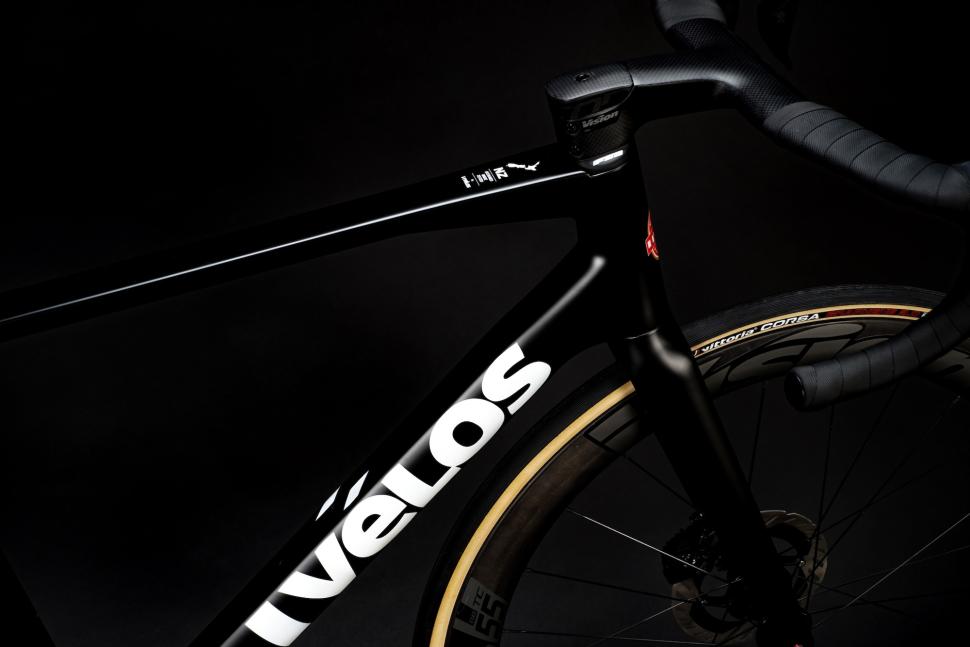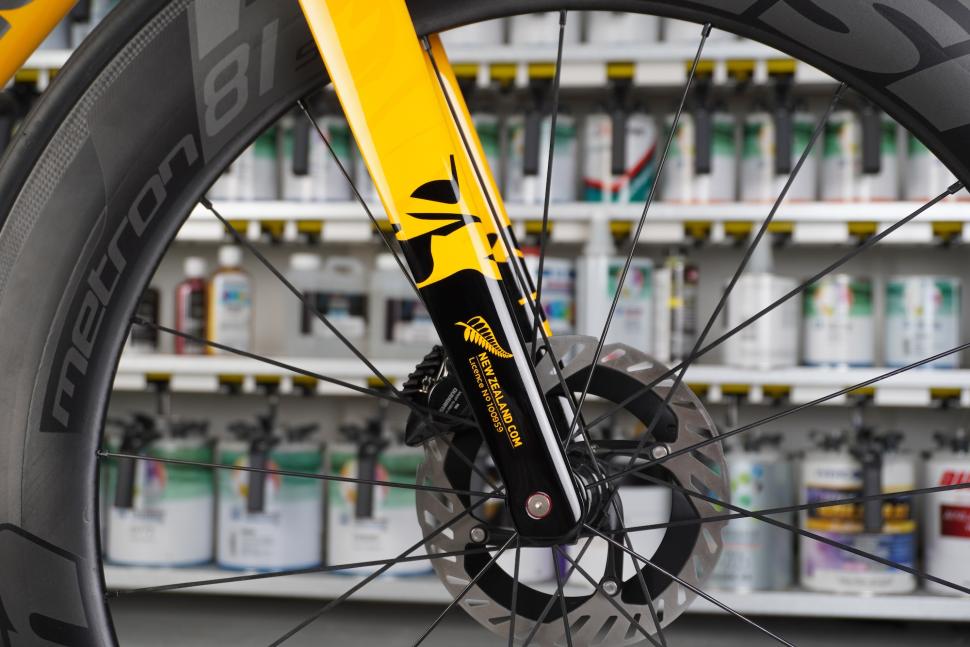- News
- Reviews
- Bikes
- Accessories
- Accessories - misc
- Computer mounts
- Bags
- Bar ends
- Bike bags & cases
- Bottle cages
- Bottles
- Cameras
- Car racks
- Child seats
- Computers
- Glasses
- GPS units
- Helmets
- Lights - front
- Lights - rear
- Lights - sets
- Locks
- Mirrors
- Mudguards
- Racks
- Pumps & CO2 inflators
- Puncture kits
- Reflectives
- Smart watches
- Stands and racks
- Trailers
- Clothing
- Components
- Bar tape & grips
- Bottom brackets
- Brake & gear cables
- Brake & STI levers
- Brake pads & spares
- Brakes
- Cassettes & freewheels
- Chains
- Chainsets & chainrings
- Derailleurs - front
- Derailleurs - rear
- Forks
- Gear levers & shifters
- Groupsets
- Handlebars & extensions
- Headsets
- Hubs
- Inner tubes
- Pedals
- Quick releases & skewers
- Saddles
- Seatposts
- Stems
- Wheels
- Tyres
- Health, fitness and nutrition
- Tools and workshop
- Miscellaneous
- Buyers Guides
- Features
- Forum
- Recommends
- Podcast
feature
 2023 Vélos Advancement Holocene road bike - 3
2023 Vélos Advancement Holocene road bike - 3Check out the Vélos Advancements Holocene superbike made from recycled carbon fibre
New Zealand-based Vélos Advancements is taking pre-orders for its Holocene road bike which is made using recycled carbon fibre and is due to be released in 2024.
The recycling of carbon fibre is big deal because, let’s be honest, from an environmental point of view, the material is bad news.
Trek announced the bike industry’s first carbon fibre recycling programme way back in 2011 and several companies have since announced their own recycling programmes, but untold thousands of carbon-fibre bikes end up in landfill every year.
Earlier this year, we told you that academics in Australia had developed a new way of recycling carbon fibre waste. It is estimated that 840,300 tonnes of waste material carbon and glass fibre composites (CFRP) will be produced by 2050 unless suitable recycling methods are adopted.
Vélos’ focus isn't on what happens to the carbon fibre after it has been used in the cycling industry, it's on “taking a novel and possibly world-first approach to manufacturing its range of race bikes from waste, recycled and surplus Toray carbon fibre provided to them by SailGP Technologies and the New Zealand aerospace industry”.
The Holocene frameset is 100% recycled carbon prepreg, rather than just a small proportion.
Vélos’ composite technician Dan Burrows says. “There are no issues with using recycled fibre although for frame building, not all carbon is equal. There are only certain weight and modulus fibres that we can use to build an optimised race frame.
“We select only what we can use in the frame and all other fibre is diverted to other products where weight and performance are not as important, such as our carbon fibre bike boxes/travel cases.
“The performance attributes are exactly the same as you will find in any high-end performance-orientated race bike. After all, we are using the same supplier and the same carbon as most of the big players: Toray.”
Vélos says that it set out to design the Holocene as its “first sustainable superbike with an emphasis on repairability, longevity and world-beating speed”.
The frame is made as a “true one-piece monocoque” with no joints. Most other frames are made up of different moulded sections bonded together. Vélos says that its technique means a stiffer frame, lower weight, and no potential for joint failures. It also argues that you get a superior ride quality.
We can’t tell you anything about the performance because we’ve not ridden the Holocene, but Vélos says that the unpainted 56cm frame and fork come in at 900-950g. The frame AND the fork together weigh well under 1kg? Vélos isn’t talking about just the frame here? We queried that and were told that the weight range definitely covers both the frame and fork together, free of hardware and paint.
If true, that’s amazingly light. Specialized claims a weight of 685g for its S-Works Tarmac SL8 Fact 12r frame in a 56cm size, and 358g for the fork. That’s a total of 1,043g – so heavier than Vélos’ claimed weight. Sticking with Specialized, the US brand claims a weight of 588g for an S-Works Aethos frame in a 56cm size, and 270g for the fork. That’s a total of 858g – so lighter than Vélos’ quoted weight range. We’re reporting Vélos’ claimed weight rather than corroborating it.
Vélos has worked on maximising the potential life of its product. For example, the Holocene frame comes with a Vélos Mast System – an integrated seat post – so there’s no seat camp or wedge. This means there’s no chance of slippage or compression damage to the frame or seat post.
The bike features “zero compression fittings such as rivnuts [rivet nuts] to eliminate corrosion and spinning in the frame”.
Vélos says that the frame is easy to fix if it ever gets damaged, the idea being that long-life products both save money and are more friendly to the environment.
“Our bikes are designed with repairability and longevity in mind,” says Dan Burrows. “We want to see extended lives for our products. Designing in repairability and having the means in our factory to do these repairs is a real point of difference.”
What about when the Holocene does reach the end of its life?
“There are several companies around the globe that take carbon fibre goods as feedstock, processing it into usable cut fibre,” says Dan Burrows. “End uses are forged carbon parts like those used by Lamborghini in their fairings, chassis and interior panels of their cars, for example.”
This is the same for any carbon fibre frame rather than being something that’s unique to the Vélos Holocene.
Vélos brought in Dave Higgins, formerly head of engineering and design at Avanti Bikes, to bring its concepts to life.
“Dave’s designs have won World Championship, Olympic and Commonwealth Games medals on the track, professional stages on the road, and outside of cycling his designs even had a role in Team New Zealand winning back the America’s Cup in Bermuda,” says Vélos.
You can choose the Holocene frame size that you want, and then choose your preferred spec. Shimano Dura-Ace, SRAM Red AXS, Campanolo Super Record, and FSA WE groupsets are offered, and you can go for a Classified Powershift system to do away with the need for a double chainset and a front derailleur.
You can request any FSA/Vision component combination and you can collaborate with the Vélos team on a unique paint scheme “with your imagination as the sole limitation”. A maximum of 100 bikes will be built in 2024.
There are six size options from 50cm to 60cm, with the possibility of one more being added at each end of the range. Vélos is also floating the prospect of a gravel lineup too.
An exact price isn’t possible because each Vélos Advancements Holocene will be built to order, but the base price will be about £12,000.
Mat has been in cycling media since 1996, on titles including BikeRadar, Total Bike, Total Mountain Bike, What Mountain Bike and Mountain Biking UK, and he has been editor of 220 Triathlon and Cycling Plus. Mat has been road.cc technical editor for over a decade, testing bikes, fettling the latest kit, and trying out the most up-to-the-minute clothing. He has won his category in Ironman UK 70.3 and finished on the podium in both marathons he has run. Mat is a Cambridge graduate who did a post-grad in magazine journalism, and he is a winner of the Cycling Media Award for Specialist Online Writer. Now over 50, he's riding road and gravel bikes most days for fun and fitness rather than training for competitions.
Latest Comments
- stonojnr 1 sec ago
he could get one of those flame thrower dog robots, might concentrate the minds of the drivers abit, the speed detector signs that article talks...
- ubercurmudgeon 5 min 17 sec ago
The apple does not fall far from the tree. Former colonies do tend to exaggerate the traits of their colonizing powers, to the point of caricature....
- stonojnr 17 min 44 sec ago
we could get Mr Loophole to take the case....
- Grumpy17 1 hour 38 min ago
This would be fairly simple for train staff to 'police',up to a point....
- grOg 7 hours 55 min ago
As soon as I saw the video, I thought; unlicensed rider, stolen bike with stolen plates; that sort of criminal wouldn't give a second thought about...
- NOtotheEU 9 hours 30 min ago
I recieved an email this week from a WMP officer drafted in to help as they were overwhelmed with submissions and falling behind. It said two of...
- quadtodd 12 hours 8 min ago
You might have missed this: ...
- michael.macklin@va.gov 15 hours 31 min ago
Calipers: not apealing.Red Levers: The Most Beatiful Levers In The World ! Gonna work some overtime.
- Saxtoo 16 hours 10 min ago
Suvi is getting paid way too much. Needs a wages review. And quick....


Add new comment
1 comments
That's a good looking superbike! I'd have some concerns re: weight if I were an early adopter, but even if the claims are there or thereabouts it's still looks an absolute weapon of a bike..
I wonder which of the many alternatives to rivnuts they use?